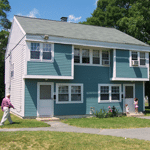When the New Bedford Housing Authority (NBHA) in New Bedford, Massachusetts, needed to lower its energy costs, it used sustainability measures to do so. For the NBHA, sustainability has been the driving force for the town’s public housing hub in the past two years, with myriad heat, water, and energy-related changes, but the process itself has breathed new life into its finances to create an overall more sustainable operation.
Because the NBHA doesn’t charge tenants for utilities, utility costs were getting to be out of control. “It was clear that we needed to do something to lower our energy costs,” says Steve Beauregard, executive director of the NBHA, “or we weren’t going to be in business much longer.”
The NBHA installed photovoltaic panels on 12 buildings at its Bay Village site and on 13 buildings at its Westlawn development, resulting in substantial savings in its electric costs. Although the systems went live just over a year and a half ago in November 2011, they have already generated more than 110,000 kilowatt-hours of electricity. The authority also received just more than $100,000 in funding from the Low Income Affordability Network (LEAN) to install micro-CHP units in three state-funded duplex buildings. These units took the place of furnaces that had been in use for nearly 25 years.
The transformation of the NBHA extends well beyond these examples; thanks to the Low Income Multi-Family (LIMF) Program. For interior lighting upgrades, the organization installed more than 9,000 CFL bulbs in tenant-owned light fixtures and added motion-sensor CFLs to buildings with common interior hallways and offices, saving more than $168,000. On building exteriors, the NBHA used LEDs instead of the 900 existing high-pressure sodium lights, saving more than $330,000. And more than 200 old fridges were replaced with Energy Star Frigidaire refrigerators, which should save $125,000 in utility costs. All told, savings are upward of $620,000.
Now, the housing authority is in the process of upgrading to more water-efficient toilets in hundreds of its units. “Many of our units still have 3.0 GPF toilets, so this upgrade will be a substantial saving in their water costs,” says Anne Shoemaker, the director of modernization.
Public housing units in New Bedford now also benefit from exterior weather stripping around doors and doorways, new door sweeps, foam insulation, hot and cold pipe insulation, and new pipe-fitting on clothes-dryer transition ducts. Shoemaker emphasizes the importance of having a complete team of architects, engineers, and contractors on the same page for such substantial undertakings to work. “There’s no way anything can get done at a place like this otherwise,” she says. “You also have to have an executive director who’s going to put a priority on this. That’s what [Steve Beauregard] does . . . he views the housing authority as a business.”

